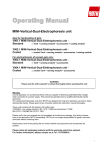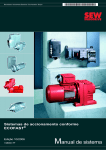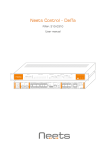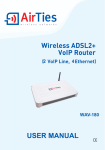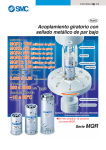Download karel dt04 dect base unit technical reference & user's
Transcript
KAREL DT04 DECT BASE UNIT TECHNICAL REFERENCE & USER’S GUIDE Version AAB KAREL reserves the right to make modifications in product features mentioned in this document for development and improvement purposes, without prior notice. Individual products may possess characteristics different from those mentioned in this document, according to their software and hardware versions. CAUTION! Since DT04 DECT Base Unit is an electronic-based system, it contains modules that carry high voltages, which could adversely affect environmental conditions. In this regard, the requirements below should be fulfilled in order for your terminal not to create any situation against you or the environment: The device must not be disassembled by unauthorized persons in any way. The cover of the unit cabinet should always be kept closed. Prior to hanging the terminal on the wall, one should make sure screws are not defective. Precautions must be taken in order to prevent any harmful substances from leaking or spilling into the terminal or its power adaptor in any way. Failure in fulfilling those requirements may result in vital hazards! Dear Friend of KAREL, In order to maintain sound operation of the system, make sure the requirements below, which are related to the environment in which the terminal will be installed, are fulfilled. ♦ Make sure the screws by which the exchange will be hanged is at least 150 cm. above the floor. ♦ Have your exchange installed in places, which are not exposed to direct sunlight, and not humid, with an environmental temperature of 0-40oC and which should be ventilated well. There should be a practical lighting in the room. The terminal should not be exposed to effects of dust, vibration, oil and water. ♦ Devices that generate high frequency waves (such as welding machines, office equipment such as computers and telex machines, air conditioners, TV sets) should not be in the same room if possible, and they should be at least 3 meters away from the terminal, otherwise. ♦ Since frequently interrupted mains supply would affect normal operation of the system, take care in making the power connection of the system special for the system. PREFACE This DT04 guide provides an overall information on Karel DT04 DECT PABX. This guide is formed up of three main chapters: 1) Technical reference: The system outline is given. Also the detailed technical information about the design technology is provided. 2) Stand-Alone Mode: The basic system installation and registration of handsets as well as user facilities are explained for the stand-alone usage of DT04. 3) MS Series Integration Mode: The system integration wiring and programs are explained for the MS Series Integration Mode. Best regards, Karel CONTENTS I. TECHNICAL REFERENCE .................................................................................... 1 I.1. GENERAL DESCRIPTION.............................................................................. 1 I.2. POWER TO THE SYSTEM .............................................................................. 1 I.3. TECHNICAL INFORMATION ......................................................................... 2 II. STAND-ALONE MODE......................................................................................... 3 II.1. MOUNTING ON THE WALL.......................................................................... 3 II.2. CABLING ...................................................................................................... 4 II.3. REGISTRATION OF HANDSETS................................................................... 6 II.4. USER’S FACILITIES ..................................................................................... 7 CALLING AN EXTENSION .............................................................................. 7 IN ORDER TO MAKE INTERNAL CALL: ......................................................... 7 MAKING EXTERNAL CALLS........................................................................... 7 SELECTIVE LINE ACCESS.............................................................................. 7 LINE FLASH.................................................................................................... 8 ANSWERING CALLS....................................................................................... 8 IN ORDER TO AN INCOMING CALL: .............................................................. 8 CALL HOLD / RETRIEVE ................................................................................ 9 INQUIRY CALL ................................................................................................ 9 CALL TRANSFER.......................................................................................... 10 CALL PARK................................................................................................... 11 PARKED CALL RETRIEVE ............................................................................ 11 CALL BACK................................................................................................... 12 BUSY EXTENSION SIGNALING .................................................................... 13 SELECTIVE CALL PICK UP .......................................................................... 13 EXTERNAL CALL PICK UP........................................................................... 13 PASSWORD DEFINE..................................................................................... 14 PASSWORD UPDATE.................................................................................... 14 HANDSET LOCK ........................................................................................... 15 CALLING FROM LOCKED HANDSET ........................................................... 16 DO NOT DISTURB......................................................................................... 16 FOLLOW ME ................................................................................................. 17 LINE RINGING ASSIGNMENT ...................................................................... 18 CHANGING THE EXTENSION NUMBER ...................................................... 18 CHANGING THE AUTHENTICATION CODE ................................................. 19 RESETTING THE SYSTEM ............................................................................ 19 CALLING THE SYSTEM FROM OUTSIDE ..................................................... 20 LINE PROGRAMMING .................................................................................. 21 III. INTEGRATION MODE ....................................................................................... 22 III.1. INTEGRATION WIRING ............................................................................. 23 WIRING OF LINES OF DT04 TO EXTENSIONS OF MS SERIES PABX.......... 23 WIRING OF KTS DATA LINE OF MS SERIES PABX TO DT04....................... 24 III.2. INTEGRATION PROGRAMS ...................................................................... 25 DT04 AUTHENTICATION CODE ASSIGNMENT: .......................................... 25 RELOADING PORTABLE PHONE PARAMETERS TO PABX:........................ 26 BASE STATION SELECT SIGNAL:................................................................ 26 DT04 COMMUNICATION CHANNEL RESET: ............................................... 27 AUTOMATIC BASE STATION CONTROL: ..................................................... 27 DT04 BASE STATION RESET: ...................................................................... 27 PORTABLE PHONE ACCESS CODE: ............................................................ 28 III.3. REGISTRATION OF HANDSETS IN MS SERIES INTEGRATION MODE.... 28 III.4. SUMMARY FOR INTEGRATION ................................................................ 29 DT04 Technical Reference & User’s Guide I. TECHNICAL REFERENCE I.1. GENERAL DESCRIPTION Karel DT04 DECT PABX is a small wireless PABX with 4 lines and 20 mobile extensions. During wireless communications it uses DECT GAP standard defined by ETSI. The implementation of GAP profile of DECT standard makes KAREL DECT base station capable of supporting all basic call setup service requests of any DECT GAP standard handset. The outlook of DT04 is illustrated in the following figure: Figure - 1 I.2. POWER TO THE SYSTEM DT04 system has a power adaptor that can operate at the mains input of 230 ± 10% VAC, 50 Hz. and outputs DC voltages necessary for the operation of the system. The phase signal on the mains input is protected with a thermal fuse of #A2 (115°C), inside the adaptor. Below is the table, which illustrates the voltages on each pin of the power connector on the motherboard: PIN1, PIN2 = GND PIN5, PIN6 = 9VDC PIN3, PIN4 = -24 VDC PIN7, PIN8 = No Connect V.AAB 1 I.3. TECHNICAL INFORMATION Standard: DECT (Digital Enhanced Cordless Telecommunications) GAP (Generic Access Profile) Number of Channels: 120 duplex Dublex method : TDMA (Time Division Multiple Access) channels with 10 ms frame length. Operation Frequency Range: 1880 to 1900 MHz. Bit rate : 1152 kbit/s Modulation: GFSK (Gaussian Frequency Shift Keying) Speech Data Rate per Channel: 32 kbit/s Average Power Output: 10 mW per channel Communication Range: 300 m open air and 50 m indoor. Speech Path : 6 (6 handsets can speak at the same time). Average Power Consumption: 5W in case of 6 calls are supported instantaneously. Signaling Method on Trunk Lines: DTMF (Dual Tone Multi Frequency) for outgoing calls, DTMF for incoming calls because of the DISA (Direct In Subscriber Access) facility. DISA Tone Frequency: 800 Hz. Weight: 1.75 Kg (including all the peripherals and the box) Size: 30 cm x 25 cm x 6.5 cm (boxed) 2 DT04 Technical Reference & User’s Guide II. STAND-ALONE MODE KAREL DT04 DECT Base Unit can be used as a stand-alone telephone switching system. The capacity is 4 lines and 20 mobile extension. It is useful for small and medium sized enterprises which need mobile telecommunication facilities. II.1. MOUNTING ON THE WALL KAREL DT04 wireless PABX is designed to be mounted on the wall. Hence, the system comes with a template and a pair of anchor plugs and screws. The system cabinet has two pear holes at the back cover to hang the system on the wall. The template has the same dimensions with DT04, so that it can be used to choose the location of the system and to determine the points of the holes on the wall. The template also has the necessary information to hang the system on the wall. To install the system: 1) Place the template, which comes with the system, on the wall. 2) Drill two holes at the points marked as X1 and X2 on the template. 3) Drive the anchor plugs into the holes. 4) Insert the screws into the anchor plugs and fix them till the screw heads remains a few millimetres away from the wall surface. 5) Hang the cabinet on the screws. The figure below illustrates the installation of DT04 on the wall: V.AAB 3 Figure - 2 II.2. CABLING After the system is hanged on the wall, the necessary cabling should be made. See the following figure for the connector locations on the bottom part of DT04: Figure - 3 The cabling of DT04 is very easy as all the line and the power connectors are provided with standard RJ type sockets. The lines to be connected to the system may either be C.O. lines or extensions of any PABX as tie lines. First, the line cables must be connected to the system. There are four RJ11 sockets for line connections. The two pins in the middle of the RJ plugs are used and the rest of the pins are not used. After that, all you have to do is to insert the RJ plug on the line cables to the related RJ sockets on the system. 4 DT04 Technical Reference & User’s Guide So, the system is ready to run. In order to start the system the power cabling must be made. The power adaptor, is designed to be directly connected to mains socket and the free end of the power cord (coming out of the adaptor) has an RJ45 plug to be connected to the related socket (POWER) on the system motherboard. The figure below illustrates the system installed together with the power adaptor: Figure - 4 After the power adaptor is plugged, the system starts running. First, the system checks the lines automatically and then the handsets must be registered to the DT04 and the required programming must be carried. V.AAB 5 II.3. REGISTRATION OF HANDSETS All handsets to be used in the system must be registered to the base station before utilizing services of KAREL base station. The registration of a handset is accomplished in one step. This procedure assigns each handset an extension number (110-129), automatically, starting from 110. That is the first handset registered is numbered as 110, the second as 111, the third as 112 and so on like till the twentieth handset is numbered as 129. Afterwards it is possible to change the extension number of the handset as explained in the next section. Referring to the manual of the handset, start the registration procedure. On request, enter the Authentication code (PIN code). Factory default is ‘1234’. If handset is not synchronized with the base station, repeat the registration process from the beginning. There must not exist more than one DECT base stations in the neighbourhood. After the handset is registered, the number assigned to the handset can be checked, by going off-hook. When the extension goes off-hook, the extension number is shown on the display of the handset. If de-registration of the handset is required, from the relevant handset dial “#896” and then the Authentication Code. The handset de-registered from the base station may continue to synchronize to the base station, but it cannot get any service from the base station. The registration procedure of KAREL MD 2000 handsets is as follows: 1) Power on the handset by pressing the red icon key while pressing the INT key. 2) Press F/R key several times till you see REGISTER on the LCD. 3) Press O.K key. 4) While seeing Search Base 1 on the LCD, press O.K. 5) While seeing a number of 8 to 10 digits on the LCD press O.K. 6) When you see “Pin no:” message on the LCD, enter the PIN code of the base station, which is 1234 by default. 7) Press O.K key. 8) After entering the pin code and pressing OK key, the handset is automatically registered to the base and you see Multi 7 message on the LCD. 6 DT04 Technical Reference & User’s Guide II.4. USER’S FACILITIES Calling An Extension In order to make internal call: Off hook Dial extension number. Making External Calls Any idle line can be accessed to make external calls. In order to make an external call: Off hook. Receive C.O. dial tone. Dial external number. Selective Line Access A specific line can be accessed to make an external call. In order to make an external call over a specific line: Off hook. Dial line number (1 .. 4) V.AAB 7 Receive C.O. dial tone. Dial external number. Notes 1) By this method a line which is marked as out of service can also be accessed. This operation is especially useful when a line is needed to be accessed by this method but not by dialing “9”. Line Flash Allows making hook flash on the external line you are using. This feature is useful for the following applications: - If your C.O. supports supplementary services that require flash, this feature may be used. - If two or more systems are connected to each other by tie lines, such that a line of a system is an extension of the other system, then this facility allows making hook-flash on the other system. - If the external call is just terminated and the line is to be accessed again, instead of hanging up and dialing “9”, this facility can be used, to make sure accessing the same line. In order to hook-flash on a line: While going on conversing on the external line. The line is put on hold and retrieved again. Receive C.O. dial tone. Answering Calls In order to an incoming call: Your handset rings. Off hook. Converse. 8 DT04 Technical Reference & User’s Guide Notes The calling extension number can be seen on the display of the handset. If the call is an external call then the line number as 0001, 0002, 0003 and 0004 can be seen on the display of the handset. Call Hold / Retrieve Allows holding and retrieving an ongoing call. In order to put a call on hold/retrieve a call: You have an ongoing call. Hold the call. Retrieve the call. Go on conversing. Notes While a call is on hold, the telephone cannot be used at discretion. Inquiry Call Allows calling another extension during an ongoing call. In order to make an inquiry call: You have an ongoing call. Hold the call. Dial the other extension number. Complete your inquiry call. Retrieve original call. V.AAB 9 Continue conversing. Call Transfer Allows transferring a call to another extension. There are two methods to transfer a call. In order to transfer a call by announcing first: You have an ongoing call. Hold the call. Dial other extension number. Announce transfer. On hook. Party on hold is transferred to the other extension. In order to transfer a call without announcing: You have an ongoing call. Hold the call. Dial other extension number. Receive ring back tone. On hook. Party on hold is transferred to the other extension. Notes In case of a transfer, if the other extension is busy or does not accept the transfer: 10 - Press R key to retrieve the call on hold, or - Press R key twice, call another extension and transfer the call. DT04 Technical Reference & User’s Guide Call Park Allows parking an ongoing external call so that the handset can be used at discretion. In order to park a call: You have an ongoing external call. Park the call. Receive internal dial tone. Notes 1) As many lines as desired can be parked by an extension. 2) A parked call returns back to the parking extension in case it is not retrieved in 90 seconds. Parked Call Retrieve Allows retrieving the parked call. In order to retrieve the longest waiting parked call: Off hook. Retrieve the longest waiting parked call. Go on conversing. In order to retrieve a parked call by selecting the line: Off hook. Dial the parked line number (1-4) and retrieve the call. Go on conversing. V.AAB 11 Call Back Activates the system to call you back when the called busy extension gets idle. In order to call back a busy extension: You are receiving busy tone. On hook. Wait until extension gets idle. Your handset rings. Off hook. Receive ring-back tone Converse when the extension answers. To cancel the call back: Off hook. Receive internal dial tone. Notes If you are busy at the time of recall, the system cancels the Call Back automatically. 12 DT04 Technical Reference & User’s Guide Busy Extension Signaling Allows signalling the busy extension by sending a short “beep” through the earphone. To warn an extension by sending beeps: You are receiving busy tone upon dialing extension number. Notes 1. The busy extension hears a beep each time "1" is pressed. 2. While an extension is being warned from the ear, he can see the extension number of the signalling extension on the display of his handset. Then, he can press “*” to converse with the signalling extension. In this case the other party hears silence and cannot participate the new conversation. Then the signalled extension can press R key to return back to his previous conversation. Selective Call Pick Up Allows picking up the call ringing at any extension. In order to pick up a call ringing on an extension: Off hook. Dial ringing extension number. Converse. External Call Pick Up Allows answering the incoming external call ringing at any other extension. V.AAB 13 In order to pick up an external call ringing on an extension: Off hook. Converse. Password Define Allows defining a password for an extension. In order to define a password: Off hook. Dial password (000,..,999). Receive internal dial tone. In order to erase the password: Off hook. Dial your password. On hook. Password Update Allows updating the password of an extension. In order to update the password: 14 DT04 Technical Reference & User’s Guide Off hook. Dial your current password. Dial new password. Receive internal dial tone. Handset Lock Prohibits other people from using a handset for external calls. In order to lock the handset: Off hook. Dial your password. Lock the handset. Receive internal dial tone. In order to unlock the handset: Off hook. Dial your password. Unlock the handset. V.AAB 15 Receive internal dial tone. Notes 1) If the password is canceled while the handset is locked, then the handset is unlocked automatically. 2) If the password is changed while the handset is locked, then the handset can be unlocked by using the new password. Calling From Locked Handset Allows making an external call from a locked handset. In order to make a call from a locked handset: Off hook. Dial your password. Receive C.O. dial tone. Dial external number. Do Not Disturb Rings the handset only once for each incoming call. In order to activate do not disturb: Off hook. Receive internal dial tone. 16 DT04 Technical Reference & User’s Guide In order to cancel do not disturb: Off hook. Receive internal dial tone. Notes The call can be answered even after the handset stops ringing, provided that the calling party is still on the line. Calling party receives ring back tone until the call is answered. Follow Me Allows forwarding all calls to another extension. In order to activate follow me: Off hook. Dial the other extension number. Receive internal dial tone. In order to cancel follow me: Off hook. On hook. Notes 1) Several extensions can be forwarded to the same extension. 2) If E1 forwards his calls to E2 and E2 forwards his calls to E3, incoming calls for E1 keep ringing on E2. Thus an endless loop of call forwarding is prevented. V.AAB 17 Line Ringing Assignment Allows assigning a line to ring on the extension’s handset. In order to set the ringing extensions for the line calls: Off hook. Dial current AC The line number (1-4) Receive internal dial tone. Notes 1) By default all lines ring on extension 110. 2) A line rings on the extension, who defines himself as the ringing extension for this line most recently and the previous ringing extension is deactivated automatically. Changing The Extension Number Allows changing the extension number. In order to change the extension number of the handset: Off hook Dial current AC Dial new extension number (110-199) 18 DT04 Technical Reference & User’s Guide Notes 1) If the extension number which you have entered as your new extension number is already defined as the number of another extension, then you receive a beep tone from the handset indicating that the code is not accepted. Then the handset must be on hooked. 2) When the handset is off hooked after the extension number is changed, the new extension number is shown on the display of the handset. Changing The Authentication Code Allows changing the authentication code of the system. In order to change the authentication code: Off hook Dial current AC Dial new AC (4 digits) On hook. Notes 1) If in the step to enter the current AC, a wrong AC is dialed, then the handset goes on hook automatically and the AC remains unchanged. 2) By default, AC = “1234”. Resetting The System Allows resetting the system to set all the parameters to their factory default. In order to set the factory set values for the parameters: Off hook V.AAB 19 Dial AC On hook Notes 1) The system must be reset if there are no active calls established. 2) After this operation, the handsets previously registered to the base station continues to synchronize, but they can not get service. They must be registered to the system again. 3) The Authentication code if changed previously, is set to “1234”. Calling The System From Outside Allows accessing any extension of the system by calling through any line of the system from outside. In order to call the system via a DISA marked line: The external party dials the number of any line of the DT04 system from his DTMF telephone. If the line is DISA, DT04 system sends a DISA dial tone. Otherwise, ring-back tone is received. The external party must dial an extension number within 15 seconds. The external party converses with the answering extension. Notes 1) As the lines are DISA, the caller has 15 seconds to dial an extension number. If he fails to dial a complete number then the extension defined as ringing extension for this line by Line Ringing Assignment feature is ringed. 20 i. If this extension is busy at that time then one of the other extensions, which are defined as ringing extensions for other lines, is ringed. ii. If this extension turns his handset off, then the line is released automatically. DT04 Technical Reference & User’s Guide 2) If the caller dials an irrelevant extension number after receiving the DISA dial tone then the line is released automatically. Line Programming DT04 assumes no external line is connected to itself on factory default. After PSTN lines are connected to external lines of DT04, these lines are to be programmed by the user. This programming allows the user to program each line as “inactive”, “active but no DISA”, “active and DISA”. In order to set the states of the lines: Off hook Dial AC Factory default is “1234” Dial status of Line 1 (0 , 1 or 2) Dial status of Line 2 (0 , 1 or 2) Dial status of Line 3 (0 , 1 or 2) = 0 : Line is out of service = 1 : In service without DISA = 2 : In service with DISA Dial status of Line 4 (0 , 1 or 2) Receive internal dial tone On hook Notes By default, all lines are out of service. V.AAB 21 III. INTEGRATION MODE KAREL DT04 DECT (Digital Enhanced Cordless Telecommunication) telephone system can be used as an expansion of KAREL MS series PABX systems. The intelligent integration provides mobility to the users as well as capacity expansion for the system. DT04 can be integrated with MS48, MS48S, MS128 and MS224 systems. Up to four DT04 DECT Base Units can be connected to an MS Series system. Thus the coverage for mobility is increased with respect to the requirements of the installation site. Roaming as a key facility is supported between the base units to support mobility in the real meaning. Thanks to the intelligent structure of the integration, all the users with mobile handsets can use all the facilities of feature rich MS Series systems via their handset just as using an SLT (Single line telephone). The following table illustrates the capacity used and gained via the DECT integration on MS Series systems. MS48/ MS48S/ MS48-ISDN MS128 (Through hole CPU) MS128 (SMT CPU) MS224 22 Extensions used Handsets added Speech channel Coverage Extensions used Handsets added Speech channel Coverage Extensions used Handsets added Speech channel Coverage Extensions used Handsets added Speech channel Coverage One Two Three Four DT04 Integrated 4 20 4 min. 4 20 4 min. 4 40 4 min. 4 40 4 min. DT04s Integrated 8 20 8 good 8 20 8 good 8 40 8 good 8 40 8 good DT04s Integrated 12 20 12 better 12 20 12 better 12 40 12 better 12 40 12 better DT04s Integrated 16 20 16 best 16 20 16 best 16 40 16 best 16 40 16 best DT04 Technical Reference & User’s Guide Extension used: Is the number of analog extensions of the MS Series PABX used for integration wiring (see next section) Handsets added: Is the number of mobile handsets that users can use after integration. Speech channel: Is the number of maximum mobile handsets that can speak at the same time. Coverage: Is the range of coverage in a comparative way. III.1. INTEGRATION WIRING The wall mounting method is the same as explained in section II.1. After the wall mounting is finished, then the wiring can be made as explained below. In order to integrate a DT04 DECT Base unit to an MS Series system, the wiring should be made in an appropriate way and in order as explained through the rest of this section. For the integration there are two main phases of wiring: A) Wiring of lines of DT04 to extensions of MS Series PABX, B) Wiring of KTS Data Line of MS Series PABX to DT04. In order to start the systems correctly, first the wiring of lines and then the wiring of the KTS data line must be made. Wiring of lines of DT04 to extensions of MS Series PABX To make the line wiring between DT04 and MS series PABX, any four extensions (successive and not including the operator extension) are connected to the four lines of the DT04. Each connection is made by a standard cupper wire pair. Polarity of the connection is not important. This wiring is illustrated in the figure below: V.AAB 23 Figure – 5 See figure – 3 for line connections of DT04. Wiring of KTS Data Line of MS Series PABX to DT04 To make the KTS Data Line wiring between DT04 and MS series PABX, the two pins – GND and DATA – of the KTS line are used. The wiring differs with respect to the hardware revision of the DT04 motherboard. The KTS data line connection can be made from the connection box of any OP48, LT48 or FT10 as well as any other data using module. For the DT04 motherboard of revision R04: Figure - 6 24 DT04 Technical Reference & User’s Guide For the DT04 motherboard of revision R06: Figure - 7 As the data wiring is made to the connection box of DT04 as shown above a one to one cable with RJ11 connectors at both ends, is used to finalize the wiring. One end of this cable is plugged in the connection box and the other end is connected to the DT04. See figure – 3 for the KTS Data connector on DT04. The KTS Data outputs of the MS Series PABXs vary with respect to the system type. For MS48 and MS48S systems the same KTS outputs used for the proprietary telephones are used. For MS48-ISDN, MS128 and MS224, the ISDN KTS outputs are used. As the KTS Data line is connected after the line wiring and after the DT04 and MS Series PABX are power on (see section II.2. for power supply connection of DT04), the DT04 starts controlling the 4 line connections. These can be monitored by the relay clicks on the DT04 systems. For each line the corresponding line relay is activated and released. If this does not happen, or if the lines are not connected properly, the DT04 integration cannot function properly. III.2. INTEGRATION PROGRAMS The program codes given below are to be entered from the system supervisor of the MS Series PABX when the PABX is in the programming mode (refer the MS Series Programming Guide for details on the programming mode). The MS Series PABX software version must be 3.11 or better. DT04 Authentication Code Assignment: Allows defining a authentication code on the MS Series PABX, so that the portable phones, which are to be registered to the base stations, can be directly registered to the PABX. 80750 P V.AAB 25 Parameters P = 0000..9999 : Four digit authentication code. By default P=1234 Notes 1. Once the integration is made, the authentication code defined by this program must be used while registering handsets. 2. Just one DT04 authentication code is defined by this program being independent of the DT04 Base Station number connected to the system. 3. The system does not recognize portable phones unless the correct pin code (defined by this program) is entered during the registration process. Reloading Portable Phone Parameters To PABX: This program allows reloading the parameters of portable phones of all DT04 base stations to the PABX. Also refreshes the communication between the base stations. 80751 Notes This is the first code to dial in case of an unexpected situation about the access to portable phones. Base Station Select Signal: This program determines how often the RSSI-START message is transmitted. This message is used to force the hand units to choose the best base station when there are more than one base stations. 80756 T Parameters T = 1..9 : Broadcast time in minutes. =0 : RSSI-START message is not transmitted. By default T= 0 Notes 26 DT04 Technical Reference & User’s Guide If all base stations are idle then this message is transmitted in t minutes. If any of the stations is not idle then a control is made in every 20 seconds till it gets idle. DT04 Communication Channel Reset: This program erases connection channel (extensions of PABX, which are connected to lines of DT04) data of all DT04 base stations connected to the system. In this case, all DT04s must be turned off and on again. When the DT04s restart, they communicate with the PABX and load all the correct parameters in the PABX memory. This program is especially useful if there is something wrong with the access to / from DT04s. 80757 Notes There is no need to use this code unless the order of cables are changed or a problem occurs in a line. Automatic Base Station Control: When this code is dialed, the base stations, which were disconnected from the PABX are found automatically by the PABX, and then the parameters of these base stations, are erased. 80758 Notes 1. If a base station is removed from the PABX then this code must be dialed 1 minute later after serial data connection between the PABX and the base station is removed. 2. The registration of portable phones are not erased even they were registered to the system via the base station removed. DT04 Base Station Reset: This program sets all DT04 parameters to their initial values. 80759 Notes Access codes of portable phones are not changed. V.AAB 27 Portable Phone Access Code: An access code is given automatically by the PABX to each portable phone registered. If it’s required changing this number then the portable phone must be first deregistered from the PABX, the number is changed by flexible numbering facility of the PABX and then re-registered to the PABX. Notes Wireless extensions’ access codes and relay access codes are given in the table below in the case where flexible numbering plan is not changed at all. III.3. REGISTRATION OF HANDSETS IN MS SERIES INTEGRATION MODE Refer to section II.3. for the details of registering a handset. In the registration procedure, it is important to pay attention to dial the authentication code defined on MS Series PABX instead of the authentication code of the DT04 DECT Base unit. Once the integration is made on the MS Series PABX, the number of the registered handset as assigned automatically by the MS Series PABX itself. The following table shows the default numbering plan of the DECT handsets. MS Series PABX Physical numbers to Default Number numbers for be used for of flexible handsets handsets numbering Relay activation code Physical relay code to be used for flexible numbering MS48 MS48S 20 200..219 151..190 151 191 20 260..279 235..274 235 275 40 260..299 235..274 255 275 40 1500..1539 311..350 351 351 MS48-ISDN MS128 (Through hole CPU) MS128 (SMT CPU) MS224 The number of DECT handsets can be changed by flexible numbering. Once the integration is finished and the handsets are registered, then the system is ready for use. Under these circumstances, all the mobile users are 28 DT04 Technical Reference & User’s Guide capable of using the same facilities through their DECT handsets as they can use from their fixed telephones. III.4. SUMMARY FOR INTEGRATION A) Make the line cabling between the lines of the DT04 and the extensions of the MS system. B) Prepare the data wiring of the DT04: Make the wiring as explained in section III.1. To check the wiring, power on the DT04 first and then connect the data cable to the base station. C) Clear the settings of the handset. To do that: 1. 2. 3. D) After correcting the wiring and turning on the systems, Wait till the relay clicks on DT04 is heard and after that dial the followings from MS system supervisor telephone in the given order: 1. 2. 3. 4. 5. E) 877777 807 57 807 58 807 59 807 50 **** (**** is any four digit pin code that you will use to register the handsets) To register the handsets to MS system trace the followings, on the handset: 1. 2. 3. 4. 5. F) Turn off the handset. Press and hold the Int key and turn on the handset in this position. Press F/R key. Then you will see "Not Sub" on the display of the handset. Press F/R key several times till you see "Register " on the display of the handset. Press O.K. key and see "select bs 1" on the display. Press O.K. key to see the base id on the display. Press O.K. key to see "PIN:" on the display and enter the pin defined with 80750 coded program above. Press O.K. key to confirm the pin entry. Now the handset is registered to the MS system. The first handset registered to the system will have first extension number given in the table V.AAB 29 in section III.3. The operator of the system can be called and thus the handset can be tested. 30





































